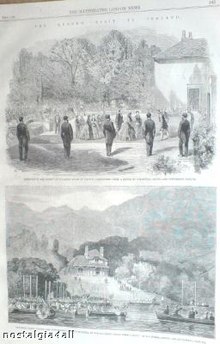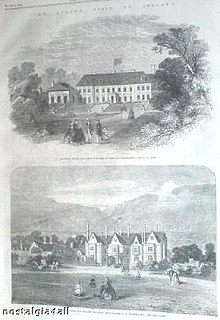Kenmare House
Kenmare House is a country house on the east bank of Lough Leane in County Kerry, Ireland and was the headquarters of the Browne family from Killarney , Earls of Kenmare .
history
Sir Valentine Browne and his son, also called Valentine , were the first family members to settle in Ireland; Sir Valentine had been appointed Surveyor General of Ireland in 1559 . In 1588, the year of the battle with the Spanish Armada , Sir Valentine signed an agreement with the McCarthy Mór to lease land from Coshmang and Ross . Unlike most of the English settlers since the Reformation , the Brownes soon returned to the old religion and the family received the royal title of "Viscounts Kenmare" from King James II in 1689 . It should be noted that this title is derived from Kenmare Castle at Hospital in County Limerick , also owned by the Brownes, and not, as one might assume, from the town of the same name . The family's first residence in Killarney was Ross Castle .
The original Kenmare was built in 1726 after the 5th Baronet and 3rd Viscount of Kenmare got his lands back. It was a magnificent French château-style building , possibly influenced by the time Browne had spent with King James II in exile at Saint-Germain-en-Laye Castle . The house stood on the 548 km² estate of the Brownes, who remarkably, despite their insistence on the Catholic denomination , were able to keep their lands during the period of the penal laws.
Viscount Kenmare designed the house himself. It was two stories high and had an attic with dormer windows and a steep slate roof . The main front had 13 bays and projecting wings three bays wide were attached on both sides. In 1775 a wing was added for the servants.
The 4th Viscount Kenmare, Thomas Browne , is credited with bringing tourism to Killarney. He was also the chairman of the Catholic Committee. In the years that followed, poets such as Tennyson and Wordsworth and writers such as Sir Walter Scott and Jane Austen visited Killarney.
Early writers praised the house: Smith (1756) praised the seat and gardens, as did Coquebert (1790) who mentioned that the open fireplaces were made of marble (pink, gray, and black). O'Donovan (1846) thought it was a pretty house, wonderfully shaded by trees and bushes.
On August 26, 1861, Valantine, Lord Castlerosse , hosted Queen Victoria and Prince Albert in Killarney. The royal visit made Killarney known as a travel destination and established the prosperity and popularity the city enjoys to this day. It must also have been the Queen and the Prince's last trip together, since the Prince died in December 1861. During her visit to Kenmare House, Queen Victoria also chose the location of Killarney House , a large Victorian and Tudor style mansion that was the successor to Kenmare House. In June 1866, King Leopold II of Belgium visited the Kenmares in Killarney.
This first Kenmare House was demolished by the 4th Earl in 1872. The successor property was destroyed in a fire in 1913 and never rebuilt. Instead, the stables of the original Kenmare House were converted into what is now Killarney House, even if the Brownes called it "Kenmare House". In the years before the First World War , King Edward VII and Queen Alexandra and later King George V and Queen Maria visited the Kenmares.
Sir Edwin Lutyens (the architect of Lady Kenmare's brother, 3rd Baron Revelstoke , at Lambay Castle on Lambay Island , County Dublin ) advised Lord Kenmare on the construction of the second Kenmare House in 1915. This house was later abandoned and sold to John McShain in 1956 , when a new Kenmare House was built for the heiress of the Brownes lands, Mrs. Beatrice Grosvenor (granddaughter of the Duke of Westminster ).
Less than 20 years later, in 1974, the new country house Mrs. Grosvenor confusingly built in 1956 on the site of the former Killarney House was replaced. This final Kenmare House was built on Killorglin Road , next to the Killarney Golf Course and the Castlerosse Hotel .
The 1985 sale of Kenmare House to County Kerry-born Denis P. Kelleher effectively marked the end of the Kenmare family's holdings in Killarney after 450 years.
In 2011 Leo Varadkar announced a € 7 million restoration of the house. A € 7 million restoration was announced by Leo Varadkar in 2011.
Individual evidence
- ↑ € 7m restoration for Killarney House announced . In: RTÉ News . August 2, 2011. Retrieved January 18, 2019.
- ^ Anne Lucey: Killarney House to be restored . In: The Irish Times . July 30, 2011. Retrieved January 18, 2019.
Web links
- Mention of Killarney House in the Irish Parliament.
- Public Record Office of Northern Ireland: Introduction Kenmare Papers . November 2007.
- Killarney National Park: Knockreer House .
Coordinates: 52 ° 3 ′ 55.6 ″ N , 9 ° 32 ′ 12.6 ″ W.




